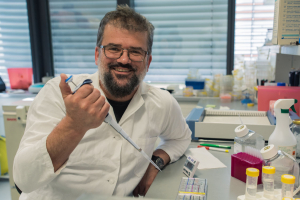Czech-Japanese cooperation – a new way of treating achondroplasia
Prevent activation of the cellular receptor, which slows growth and causes achondroplasia. A groundbreaking method of treating genetic disorders of growth has been described by scientists from the International Clinical Research Center of St. Anne’s University Hospital Brno (FNUSA-ICRC) and Masaryk University in Brno, together with Japanese colleagues.
The key substance in this case is an RNA aptamer with the James Bond name RBM-007, which acts as a ligand trap. Ligands are usually small proteins that form complexes with cellular receptors and can activate them. In the case of achondroplasia, it is the FGFR3 receptor whose increased activity slows the growth of cartilage cells. An aptamer is an engineered portion of a ribonucleic or deoxyribonucleic acid that binds to a ligand that can no longer activate FGFR 3 receptors, thereby preventing growth disorders.
Pavel Krejčí, head of the FNUSA-ICRC Cell Signaling research team, contributed significantly to this discovery. “The Japanese company developed this RBM-007 for the treatment of AMD (Age-related Macular Degeneration), however, we noticed its potential for the treatment of growth disorders and started working in this area,” Krejčí described the beginnings of the cooperation. That was five years ago and now RBM-007 is entering the first phase of clinical trials and is being tested in Japanese patients. The results are very promising, however, testing a new drug is a long way off. “Drug for achondroplasia – Vosoritide, which I participated in the research, will reach the first patients after more than sixteen years,” Krejčí added.
The main focus of the FNUSA-ICRC Cell Signaling team, ie research into receptor tyrosine kinases, which currently includes FGFR3, is far from over. “Currently, we have about fifteen projects under development,” Krejčí confirmed. One is the study of aptamers that would not function as a ligand trap but inhibit receptors directly. The result could be a new generation of molecules with great potential for the treatment of diseases related to damage to various organs, not just bones. “We are trying to create a bridge between basic and clinical research. So far, we are doing well, hopefully it will last in the future, ” added Pavel Krejčí.
The publication was published in the prestigious journal Science Translational Medicine and can be found here:
Achondroplasia is a genetic form of dwarf growth, the height in adulthood in those affected by this disease is on average 125 cm. It is the most common form of genetic growth disorder in humans, and is caused by mutations in the FGFR3 gene. In the Czech Republic, 4-5 children with this disorder are born annually. Four years ago, scientists from the International Clinical Research Center of St. Anne’s University Hospital Brno (FNUSA-ICRC) founded register of these children, thanks to which they collect data on their health.



